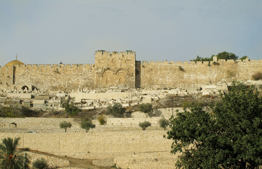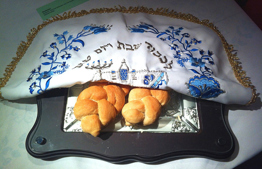Parashat Ki Tisa - Bikurim, Syria and Apmia

About the mitzvot tied to the Land of Israel and their importance, bikurim, the link to Syria and what is Apmia?
"The choice first fruits of your soil you shall bring to the house of the L-rd your G-d. You shall not boil a kid in its mother's milk." (Shemot 34:26)
"Give thanks for what is past and supplicate for the future" (Mishna Berachot 9:4)
Thank G-d, in Israel we have gotten used to the fact that the mitzvot hateluyot ba'aretz, the mitzvot tied to the Land of Israel, are part of our daily routine. We know that we can't just buy fruits and vegetables in the open market and eat them right away; even if we don't address the issue of orlah for fruit, we know we have to first separate terumot and ma'aserot even from the vegetables. During the shemita year, things get complicated seven-fold. In contrast, when we encounter the mitzvah of building the Mishkan and Beit HaMikdash, and all the sacrifice-related mitzvot, we know only too well, to our deep sorrow (until it will be built, speedily and in our days), that since the destruction of the Second Beit HaMikdash these mitzvot barely have any practical implications on our daily lives.
Let's admit that we have a short-term memory. Our forefathers that made Aliya from exile, as scrupulous as they were about mitzvah observance, were not familiar with the mitzvot tied to the Land of Israel—at least not in practice. While they were meticulous about every detail of kashrut, especially as it related to the second half of the verse above—with the laws of meat and milk—they were not accustomed to the fact that even fruits and vegetables have mitzvot and halachot associated with them. Today we have the great merit that the mitzvot tied to the Land of Israel have entered the list of halachic requirements observed by every G-d fearing Jew in Israel.
This situation, that our forefathers could only read about in the Mishna and Gemara, but is an integral part of our everyday lives, we can only give tremendous thanks to G-d for.
However, together with our enormous sense of gratitude, that we are obligated to express to as not to be ungrateful, G-d forbid, we must remember what we still so sorely lack. We need to pray and long for the Beit HaMikdash and its service, feel pained in its absence, and take action to hasten its rebuilding.
Bikurim: a mitzvah tied to the Land of Israel and the Beit HaMikdash
Anyone who ever separated terumot and ma'aserot knows that the first gift we set aside is the teruma gedola. That is true, but only today. During the times of the Beit HaMikdash, another gift took precedence. This gift was accompanied by the greatest amount of color and variety, which probably most clearly reminded us Who is truly in charge, Who gave us the strength and ability to succeed in our work. This mitzvah is bringing the first fruits, bikurim, which includes setting them aside, bringing them up to the Beit Hamikdash, giving them to a Kohen, and reading the bikurim passage.
The mitzvah of bikurim is essentially a mitzvah tied to the Land of Israel, and it would seem that we who have merited to return to the land of our forefathers, as well as to these special land-tied mitzvot, should once again observe the mitzvah of bikurim. However, the Mishna at the end of tractate Shekalim, which the Rambam codifies as halacha in Hilchot Bikurim (chapter 2), informs us that bikurim applies only when the Beit HaMikdash is standing. This is because the verse that appears in our parasha (and also in parashat Mishpatim) ties the bringing of first fruits to Beit HaMikdash. This mitzvah brings together when we already have and what we are still anticipating. It seems that only when the Beit HaMikdash is rebuilt will we truly be able to remember our humble roots ("My father was a fugitive Armean. He went down to Egypt, etc." the bikurim text, Devarim 26:5), and Who brought us to where we are today ("Wherefore I now bring the first fruits of the soil which You, O L-rd, have given me." ibid., 26:10).
A trip to Syria
While we're talking about a mitzvah that we have not yet the merit to observe, we might as well discuss a region that is supposed to be under Israeli sovereignty, but it not yet.
First fruits from Syria
The Mishna at the end of tractate Challah tells us about people who bring priestly gifts: challah, the firstborn of domesticated animals (bechor), and bikurim not at proper times or from the right places, which is why these gifts were not received from these individuals. At the end of the list is an anecdote about a Jew named Ariston who brings bikurim from Apima. Here, too, we would expect the gift to be rejected, especially from a place with such a pronounced gentile name. However, to our great surprise, specifically in this case his gift was accepted. The Mishna also explains why this is the case: "One who purchases in Syria it is as if it is a purchase in a suburb of Jerusalem."
Where is Syria?
Just as the boundaries of the Land of Israel do not necessarily correspond with today's political boundaries of modern day Israel, "Syria," which is a halachic term, does not necessarily correspond with today's political entity by that name. It does give us a general idea, however.
Syria is a region north of the Land of Israel whose level of halachic obligation (vis-à-vis Land-oriented mitzvot) is lower than Israel proper, but higher than chutz la'aretz, outside the Land. For this reason, while bikurim are not brought from abroad, they are brought from Syria, which is why our friend Ariston's bikurim were accepted. Rambam (Hilchot Terumot 1:4) explains the reason for Syria's intermediate status:
"And why does it [Syria] have a status less than that of the Land of Israel? Since it was conquered [by King David] before the rest of the conquest of the Land of Israel. Rather, those of the seven nations remained [in Israel proper at that time]. Had the entire Land of Canaan been conquered first, including all its boundaries, and then afterwards other lands, [Syria's] conquest would be considered just like the Land of Israel for all intents and purposes. And the lands conquered by David are called 'Syria'."
This is not the place to discuss the complex topic of the Land of Israel's boundaries. However, we can safely assume that some of modern-day Syria is included within the boundaries promised to Avraham Avinu, the future and broader boundaries than the lands conquered by Yehoshua and olei Mitzrayim.
Apmia
While there are several cities mentioned in Mishnaic and Talmudic literature by the name of Apmia, it seems that the Apmia in question here was a large city situated northwest of Hama (Hamat), east of the large Syrian river Orontes (Arnt in Syriac languages). Today, these ruins are adjacent to the Syrian town Qala'at al-Madiq (a province of Hama). The city was founded by the Seleucid Greeks who stationed themselves in Syria, infamous to us primarily due to one of the kings in the dynasty: Antiochus IV, who we are familiar with from Chanukah. However, it is interesting to note that one of the spots that mark the Land of Israel's northeast (narrow!) boundary detailed in parashat Masa'ei, Shafam, is identified by the translation ascribed to Yonatan ben Uziel as Apmia.
The Jewish historian Josephus Flavius relates (The War of the Jews II 18, p. 5) that during the Great Rebellion, leading to the destruction of the Second Temple, while most Syrian gentiles massacred their Jewish neighbors, the residents of Apmia were among the few who were merciful and did not join in the carnage. Among the ruins of the glorious city, a boulevard of 1800 columns was discovered, while the width of the road reached 42 m. A synagogue from the Talmudic era was also discovered there.
The area apparently boasted extensive farmland due to the highly fertile nature of the region, thanks to the river that expanded near the city. This formed the Apmia Lake, mentioned in the Yerushalmi (Kila'im 9:3) as one of the seven bodies of water surrounding the Land of Israel. It is no wonder that Ariston's fear of Heaven motivated him to bring up his first fruits to the Beit HaMikdash in Jerusalem. He undoubtedly wished to strengthen his and his family's bond, as Jews living far from the major Jewish center, to the place of the resting of the Divine Presence. And at the same time instill within himself a sense of humility before the One who truly gives us the strength to succeed.
Apparently Ariston achieved his goal and made Aliya to Jerusalem with his family. How do we know? In 5749 (1989) in Hakel Dama (the southern section of the Valley of Hinnom), Jerusalem, a magnificent burial cave was discovered, untouched by previous generations. While one of the ossuaries (chest for skeletal remains) was broken, the inscription on it unlocked the identity of the cave. The inscription read "Ariston Ampi." So it turns out that this was the grave of Ariston mentioned in our Mishna, the fellow whose bikurim were willingly accepted.




